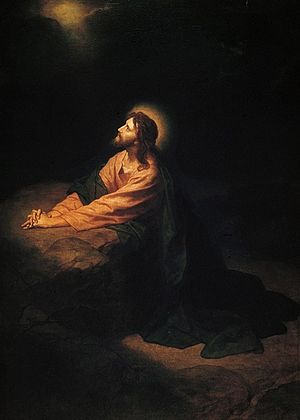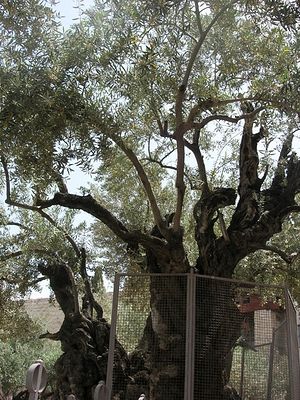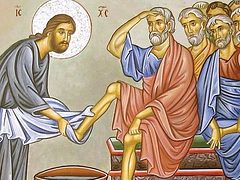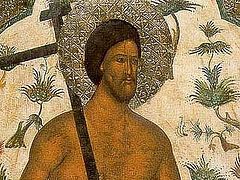On Holy Thursday was celebrated the Mystical Supper, at which the Lord gave the Mystery of His Body and Blood, the mystery of Holy Communion. The time of the Jewish Passover had arrived. Having performed all of the Old Testament rites of the Passover supper, having served the Pascha of the Old Testament, the Lord institutes the New Covenant and gives His disciples Holy Communion. Having blessed the bread, He gave it to His disciples with the words, “Take, eat: this is My Body which is broken for you, for the remission of sins.” Then He blessed the cup of wine: Drink ye all of it; For this is my blood of the new testament, which is shed for many for the remission of sins (Mt. 26:27-28).
Christ also showed the disciples an image of humility at this supper, washing their feet. The Gospel reading at Matins tells about it. St. Innocent of Kherson suggests that the dispute between the disciples about which of them was greatest arose precisely from the washing of the feet, which had to be done before the evening of Passover. There was no servant in the community, and someone should have fulfilled this custom and washed the others’ feet. But no one wanted to do it, and the disciples argued amongst themselves about the primacy. Then the Lord Himself started washing everyone’s feet, instructing them so they would learn humility.
In Christ’s farewell conversation with the disciples after the institution of the Sacrament of Communion, He reveals before them the mystery of His ministry and the essence of His teaching. He comforts and strengthens the disciples before the coming trials.
The Gospel reading at Liturgy is more extensive and leads us further along behind the Lord—to the Garden of Gethsemane, where the Lord prayed before His suffering and was betrayed by Judas to the guards whom he led there. The disciples slept, but the Lord, fearing His suffering and martyric death as a man, thrice prayed to the Heavenly Father to let the cup of His suffering pass. But His strength of spirit and His devotion to the will of God made Christ add, Nevertheless not My will, but Thine, be done. In the Garden of Gethsemane, the Lord experienced all the heaviness of inner suffering, the suffering of spirit. The cup of impending suffering and death was filled with human sins, the sins of the whole world, which Christ took upon Himself to redeem mankind from the curse of sin, to heal human nature, damaged by the fall. This is what made the Lord’s internal suffering so heavy and painful—his soul was tormented and the sins of the whole world, which He took upon Himself, pressed upon Him. In deep spiritual sorrow, Jesus wanted to arouse His disciples to pray together, but they were weighed down by drowsiness. The God-Man’s vexation was so strong that the sweat that appeared, according to the words of the Evangelist Luke, was like drops of blood falling to the ground. Christ thrice knelt in prayer, without an answer from His Heavenly Father, inasmuch as He had to utter His own answer, through self-sacrifice attaining to that union with the Father wherein all doubts vanish. But the love of the Heavenly Father did not leave the Savior without aid—an angel appeared from Heaven, strengthening Him.
This night, Judas, having finally betrayed the Lord, led a guard from the High Priest to take Jesus. The guards and servants needed some kind of sign indicating Whom they were sent out against. For this the traitor chose a kiss: Whomsoever I shall kiss, that same is he: hold him fast (Mt. 26:48). Christ, knowing what would happen, woke all the disciples and went out to meet the betrayer. Still desiring to bring the poor Judas to reason, the Lord asked him, Friend, wherefore art thou come? (Mt. 26:50). But Judas didn’t heed the Savior’s love and kissed Him, thereby giving the agreed-upon sign to the soldiers. Judas, betrayest thou the Son of man with a kiss? (Lk. 22:48) the Lord inquired of him. The guards did not dare seize Him, struck by some mysterious power emanating from Him. Twice He asked them who they were seeking. Jesus of Nazareth, the guards answered. I am He, the Lord answered (Jn. 18:4-8), remaining in place and waiting for the soldiers to seize Him. He took care only for the disciples, saying to let them go; and He turned Himself over into the hands of the guards. Peter took out a blade and cut off one of the servants’ ears, but the Lord stopped Peter and healed the ear of the wounded servant. After that, all the disciples fled in fear, with only John and Peter remaining, following the Master.
The enemies of Christ were in a great hurry, therefore the Savior was immediately led to the house of the High Priest. It was there that the three-fold denial by Peter, foretold by the Lord, occurred, him fearing that he too would be seized.
The troparion at Matins: “When the glorious disciples were enlightened at the supper during the washing of the feet, then Judas the ungodly one was stricken and darkened with the love of silver. And unto the lawless judges did he deliver Thee, the righteous Judge. Behold, O lover of money, him that for the sake thereof did hang himself; flee from that insatiable soul that dared such things against the Master. O Thou Who art good unto all, Lord, glory be to Thee!”
The Canon of Holy Thursday, the Exapostilarion: “I see Thy bridal chamber adorned, O my Savior…” The prophecy of the Old Testament prophet Jeremiah about the Savior’s sufferings, in which Christ is compared with a lamb led to the slaughter, is read at the First Hour.
The Liturgy of St. Basil the Great is served this day, combined with Vespers. Instead of the Cherubic Hymn, instead of the Communion hymn, and instead of “Let my prayer arise…” is sung the hymn “Of Thy Mystical Supper, O Son of God, receive me today as a communicant; for I will not speak of the Mystery to Thine enemies; nor will I give Thee a kiss as, as did Judas; but like the thief do I confess Thee: Remember me, O Lord, in Thy kingdom.”
After the Prayer Behind the Ambon, the Rite of the Washing of Feet is served in cathedrals, which depicts how Christ washed the feet of the disciples, and the Gospel that tells about it is read. The hierarch represents Christ, and the archimandrites or priests—the twelve disciples. In Jerusalem, the Rite of the Washing of Feet is celebrated on the square in front of the Church of the Resurrection of Christ [the Holy Sepulcher—Trans.], with Christ being represented by the Patriarch of Jerusalem.
Small Compline is served, with a three-ode canon being sung.





